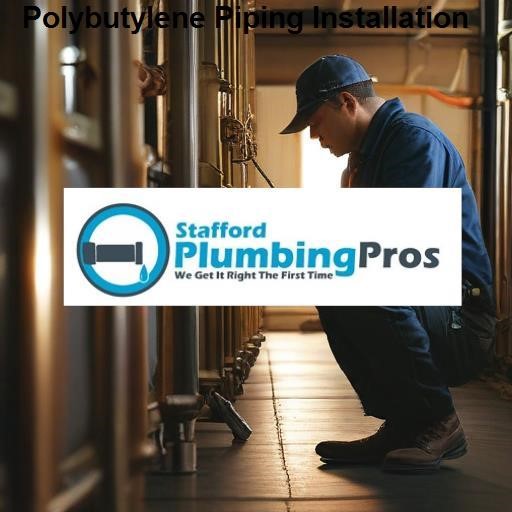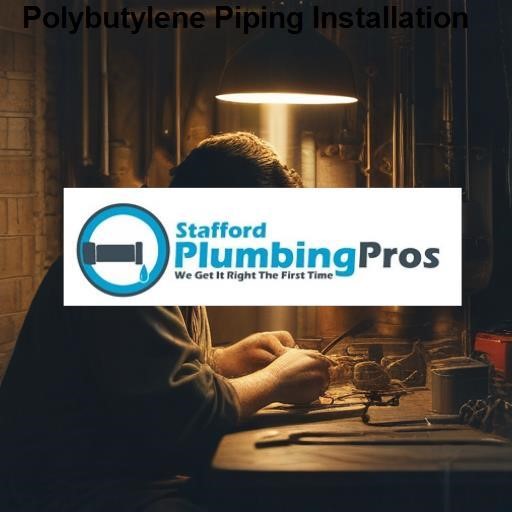Polybutylene piping may have been a popular choice for plumbing installations in the past, but its reputation for causing costly water damage has made professional Polybutylene Piping Installation services more important than ever. With Stafford Plumbing Pros, you can trust that your home is in good hands when it comes to replacing or repairing polybutylene pipes.
Did you know that polybutylene pipes were used in millions of homes across the United States from the 1970s to the 1990s? Unfortunately, these pipes have a high failure rate due to their susceptibility to chlorine and other chemicals found in water, leading to leaks and bursts that can cause extensive damage to your property.
When it comes to replacing or repairing polybutylene pipes, it is crucial to hire a professional like Stafford Plumbing Pros. With their expertise and experience, they can ensure that the installation is done correctly and efficiently, giving you peace of mind and preventing potential water damage disasters.
As a leading provider of Polybutylene Piping Installation services, Stafford Plumbing Pros prides itself on their commitment to quality workmanship and customer satisfaction. With a team of skilled technicians and state-of-the-art equipment, they are the best choice for all your polybutylene piping needs. Don't take any chances when it comes to your home's plumbing – trust Stafford Plumbing Pros to get the job done right.

Polybutylene piping was once a popular choice for plumbing in homes due to its low cost and easy installation. However, over time, it has gained a notorious reputation for its tendency to deteriorate and cause leaks. Understanding polybutylene piping is crucial for homeowners considering or dealing with this type of plumbing material.
Polybutylene pipes are made of a plastic resin and were commonly used in residential plumbing from the late 1970s to the mid-1990s. Despite its initial popularity, polybutylene piping is susceptible to becoming brittle and failing, leading to costly water damage in homes. As a result, many homeowners are opting to replace their polybutylene pipes with more durable and reliable materials like copper or PEX.
If you suspect that your home has polybutylene piping or are experiencing issues with your current plumbing system, it is essential to consult with professionals to assess the situation and recommend the best course of action. Upgrading to modern piping materials can provide long-term peace of mind and protect your home from potential water damage.

Polybutylene piping, once hailed as a cost-effective plumbing solution, gained popularity in the 1970s due to its flexibility and ease of installation. However, over time, it became notorious for its susceptibility to premature deterioration and failure. This type of piping was commonly used in residential plumbing systems until the late 1990s when issues with leaks and ruptures started to surface. The material's reaction to oxidants in water, such as chlorine, led to a high rate of failures, resulting in costly damages and repairs for homeowners. As a result, the use of polybutylene piping significantly declined, and many homeowners sought replacements to avoid potential water damage in their properties. Understanding the history of polybutylene piping sheds light on the importance of quality materials and professional installation in ensuring the longevity and safety of plumbing systems.
Polybutylene piping is a popular choice for plumbing installations due to its flexibility, ease of installation, and cost-effectiveness. One of the key benefits of polybutylene piping is its resistance to corrosion, which helps prolong the lifespan of the plumbing system. This type of piping is also known for its ability to withstand high water pressure, making it a reliable option for residential and commercial properties.
Moreover, polybutylene piping is less likely to burst in freezing temperatures compared to traditional metal pipes, reducing the risk of water damage in cold climates. The lightweight nature of polybutylene pipes makes them easy to transport and install, saving both time and labor costs during the installation process. Overall, the durability, affordability, and ease of installation make polybutylene piping a practical choice for modern plumbing systems.
When it comes to preparing for a polybutylene piping installation, there are several key steps to ensure a successful and efficient process. Firstly, it's crucial to assess the layout of the property to determine the best route for the new piping system. This involves considering factors such as the location of existing pipes, the structural integrity of the building, and any potential obstacles that may need to be addressed.
Next, our team will work closely with you to select the right type and size of polybutylene pipes for your specific needs. We will take into account factors such as water pressure, temperature, and flow rate to ensure that the new piping system will perform optimally.
Additionally, our professionals will thoroughly inspect and prepare the area where the installation will take place. This may involve clearing any obstructions, removing old piping if necessary, and ensuring that the work environment is safe and conducive to the installation process.
By taking these preparatory steps seriously, we can help ensure a smooth and successful polybutylene piping installation that meets your needs and exceeds your expectations.
Polybutylene piping, once a popular choice for plumbing systems due to its cost-effectiveness and ease of installation, has now fallen out of favor due to its tendency to deteriorate and cause leaks over time. When considering polybutylene piping installation, it's crucial to choose the right type of pipes to ensure the longevity and efficiency of your plumbing system.
There are various types of polybutylene pipes available on the market, including polybutylene random copolymer (PB-R), polybutylene terephthalate (PB-T), and polybutylene terephthalate glycol (PB-G). Each type has its own unique properties and strengths, so it's essential to consult with our team of professionals to determine the best option for your specific needs.
By selecting the right polybutylene pipes for your installation, you can ensure a durable and reliable plumbing system that will stand the test of time. Our experts can guide you through the selection process and provide you with the best solutions for your polybutylene piping installation needs.
When it comes to polybutylene piping installation, having the right tools is crucial for a successful and efficient job. Our team of professionals is well-equipped with a range of specialized tools to ensure a seamless installation process. One of the essential tools needed for polybutylene piping installation is a pipe cutter, which allows for precise and clean cuts on the piping. Additionally, adjustable wrenches are necessary for tightening fittings and connections securely.
Moreover, having a tubing cutter is essential for cutting the polybutylene piping with accuracy and ease. Teflon tape is another important tool that helps create a tight and leak-free seal between threaded connections. Our team also utilizes crimping tools to securely fasten crimp rings to the piping, ensuring a reliable and durable connection. With our expertise and the right tools at hand, we guarantee a professional and top-quality polybutylene piping installation for our clients.
Polybutylene piping installation involves a detailed process that ensures a reliable and efficient plumbing system. We begin by assessing the layout of the property to determine the best placement for the new piping. Next, our team carefully removes any existing piping, making sure to dispose of it properly. We then measure and cut the polybutylene pipes to fit the specific dimensions needed for the installation.
Once the pipes are ready, we use specialized tools to connect them securely, ensuring there are no leaks or weak points. Pressure testing is a crucial step in the process to guarantee the system functions correctly. Finally, we conduct a thorough inspection to ensure everything is in place and functioning as intended. Our professionals are trained to handle each step with precision and care, providing you with a top-notch polybutylene piping installation service.
Polybutylene piping was a popular choice for plumbing installations in the 1970s and 1980s due to its cost-effectiveness and easy installation. However, over time, it was discovered that these pipes were prone to failure and could cause significant water damage to properties. If you have Polybutylene piping in your home, it's crucial to handle it correctly. One option is to replace the Polybutylene pipes with more reliable materials like copper or PEX. This process involves shutting off the water supply, removing the old pipes, and installing the new ones. It's a job best left to professionals to ensure it's done safely and efficiently. By addressing Polybutylene piping proactively, you can avoid potential leaks and water damage in the future.
Polybutylene piping was once a popular choice for plumbing systems due to its low cost and easy installation. However, over time, it became notorious for its tendency to deteriorate and fail, leading to costly water damage in homes. When connecting Polybutylene pipes, it's crucial to ensure proper installation to prevent leaks and potential water damage. Our team of professionals understands the intricacies of working with Polybutylene piping and follows best practices to ensure a secure connection.
One important aspect of connecting Polybutylene pipes is using the right fittings and connectors designed specifically for this type of piping. Our experts are well-versed in identifying the compatible materials and techniques needed for a reliable connection. We prioritize precision and attention to detail to guarantee a leak-free and durable plumbing system for our clients. Whether it's a repair or a new installation, we are equipped to handle Polybutylene piping projects with expertise and efficiency.
Polybutylene piping was once a popular choice for residential plumbing due to its low cost and easy installation. However, over time, it has been found to be prone to issues such as deterioration and leaks, leading to the need for maintenance and troubleshooting. One common problem with polybutylene piping is that it becomes brittle and prone to cracking as it ages, especially when exposed to chlorine and other chemicals in water. To prevent potential leaks and damage, regular inspections by professionals are recommended to assess the condition of the pipes and identify any weak points. Troubleshooting polybutylene piping issues often involves locating and repairing leaks, which can sometimes be challenging due to the piping being located behind walls or underground. In some cases, it may be necessary to replace sections of polybutylene piping with more durable materials to ensure the long-term integrity of the plumbing system.
Polybutylene piping was once a popular choice for plumbing systems due to its low cost and easy installation. However, it has since fallen out of favor due to its tendency to deteriorate and cause leaks over time. If you have a home with a polybutylene system, it's essential to take proactive steps to care for it. Regular inspections by our team of professionals can help detect any signs of wear or damage early on, potentially saving you from costly repairs down the line. Additionally, considering a replacement with more durable piping materials like PEX or copper can provide long-term peace of mind. By staying vigilant and investing in the maintenance of your polybutylene system, you can ensure the safety and efficiency of your home's plumbing for years to come.
Polybutylene pipes were once a popular choice for residential plumbing due to their low cost and easy installation. However, over time, these pipes have been found to be prone to issues such as cracks, leaks, and deterioration. One common problem with polybutylene pipes is that they can become brittle and break easily, especially when exposed to chlorine and other chemicals commonly found in water.
To troubleshoot common issues with polybutylene pipes, it's essential to conduct a thorough inspection to identify any signs of damage or wear. Look out for discoloration, bulging, or flaking of the pipes, as these can be indicators of potential problems. Additionally, keeping an eye out for leaks or water stains on walls and ceilings can help detect hidden issues with the pipes.
If you are experiencing problems with your polybutylene piping, it is crucial to seek the assistance of plumbing professionals who are experienced in handling such issues. Our team of experts can provide accurate diagnosis and efficient solutions to address any concerns with your polybutylene piping system.